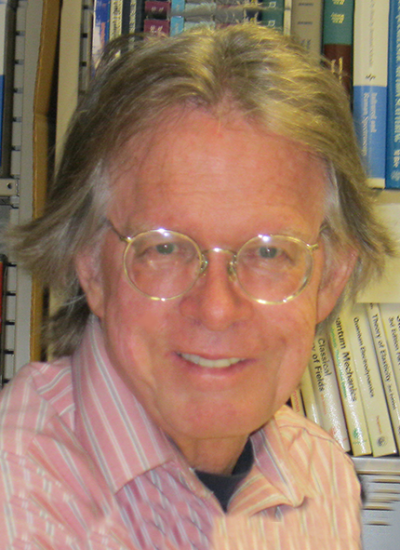Michael F Brown
Publications
Abstract:
The observation that the spin-lattice relaxation (R1Z) rates of pure phospholipid lamellar phases depend only weakly on their orientation in the liquid-crystalline state is explained. A relaxation model in which either segmental or molecular motions are described by anisotropic rotational diffusion in an ordering potential (M.F. Brown, J. Chem. Phys. 77 (1982) 1576) can account for the available 2H R1Z data to within experimental error. One possibility is that rotational isomerization breaks the symmetry of the static electric field gradient, leading to an asymmetric residual tensor which is further modulated by molecular motions. © 1990.
PMID: 3205143;Abstract:
Coronary artery disease due to atherosclerosis takes the lives of approximately 550,000 Americans each year - an enormous toll. Put in economic terms, the cost to the United States alone has been estimated to exceed 60 billion dollars annually. We have found that well-resolved proton (1H) NMR spectra can be obtained from human atheroma (fatty plaque), despite its macroscopic solid appearance. The fraction of the total spectral intensity corresponding to the sharp 1H NMR signals is temperature dependent and approaches unity at body temperature (37°C). Studies of the total lipids extracted from atheroma and cholesteryl esters were conducted to identify the chemical and physical origin of the spectral signature. The samples were characterized through assignment of their chemical shifts and by measurement of their T1 and T2* relaxation times as a function of magnetic field strength. The results suggest that the relatively sharp 1H NMR signals from human atheroma (excluding water) are due to a mixture of cholesteryl esters, whose liquid-crystalline to isotropic fluid phase transition is near body temperature. Preliminary applications to NMR imaging of human atheroma are reported, which demonstrate early fatty plaque formation within the wall of the aorta. These findings offer a basis for noninvasive imaging by NMR to monitor early and potentially reversible stages of human atherogenesis.
PMID: 1390768;Abstract:
It was recently shown that oligolamellar vesicles of 3:1 mixtures of dioleoylphosphatidylethanolamine (DOPE) and the photopolymerizable lipid 1,2-bis[10-(2′,4′-hexadienoyloxy)decanoyl]-sn-glycero-3- phosphocholine (SorbPC) are destabilized by polymerization of the SorbPC [Lamparski, H., Liman, U., Frankel, D. A., Barry, J. A., Ramaswami, V., Brown, M. F., & O'Brien, D. F. (1992) Biochemistry 31, 685-694]. The current work describes the polymorphic phase behavior of these mixtures in extended bilayers, as studied by 31P NMR spectroscopy and X-ray diffraction. In the NMR experiments, samples with varying degrees of polymerization were slowly raised in temperature, with spectra acquired every 2.5-10°C. In the unpolymerized mixiture, and in those photopolymerized samples where the monomeric SorbPC was decreased by 33% and 51%, an isotropic signal grew progressively until no signal from the lamellar liquid-crystalline (Lα) phase remained. In the highly polymerized sample with a 90% loss of monomeric SorbPC, less than 20% of the lipids underwent this transition. In none of the samples was an inverted hexagonal phase (HII) observed, under conditions of slow heating to almost 100°C. The X-ray diffraction studies indicated that samples which exhibit the isotropic NMR signal corresponded to a structure exhibiting no well-defined crystalline order, which upon thermal cycling became an inverted cubic phase belonging to either the Pn3m or Pn3 space groups. The temperature of the transition to the cubic precursor decreased as the extent of polymerization increased, demonstrating that photopolymerization of these lipid bilayers can significantly alter the composition and thermotropic phase behavior of the mixture. © 1992 American Chemical Society.
PMID: 18348566;Abstract:
Membranes made from three specifically deuterium-labeled ether-linked bolalipids, [1′,1′,20′,20′-2H4]C20BAS-PC, [2′,2′,19′,19′-2H4]C20BAS-PC, or [10′,11′-2H2]C20BAS-PC, were analyzed by 2H NMR spectroscopy. Unlike more common monopolar, ester-linked phospholipids, C20BAS-PC exhibits a high degree of orientational order throughout the membrane and the sn-1 chain of the lipid initially penetrates the bilayer at an orientation different from that of the bilayer normal, resulting in inequivalent deuterium atoms at the C1 position. The approximate hydrophobic layer thickness and area per lipid are 18.4 Å and 60.4 Å2, respectively, at 25 °C, and their respective thermal expansion coefficients are within 20% of the monopolar phospholipid, DLPC. Copyright © 2008 American Chemical Society.


